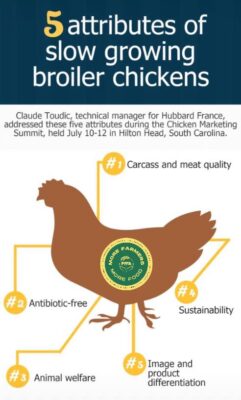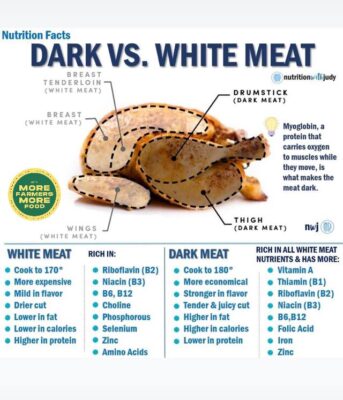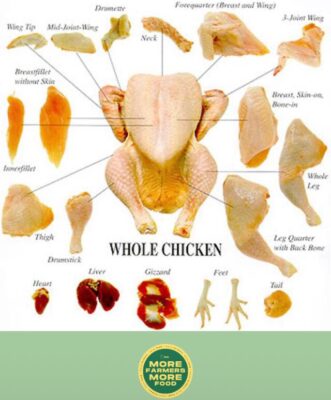Week 7 of the More Farmers More Food campaign looks at Poultry Farming
In this Article...
Poultry farming in the UK is heavily industrialised putting unethical stress on the birds grown for meat and feathers.
Poultry Farming raises birds domestically or commercially primarily for meat, but also for feathers. Chickens, ducks, turkey and geese are the most common birds within this system but other small birds such as quail or guinea fowl are produced too.
Commercial poultry uses a scientific approach with a measured intake of energy for growth and fat production. Well-balanced protein sources of food produce a maximum amount of muscle, organ and feather growth. The essential minerals in their diet produce bones and eggs.
They create carefully controlled environments to avoid overcrowding, overheating and cannibalistic attacks. This is controlled by debeaking at one day of age. The whole process of feeding, watering, egg gathering and cleaning operations are highly mechanised.
Poultry breeding has used inbreeding and cross-breeding to create maximum gain in meat production, with rapid weight gain that produces plump and meaty carcasses. A modern broiler chicken can reach a 2-3kg market weight in 5 weeks, compared to the 4 months it took in the old days.
There are a lot of diseases that can be spread within this industrialised process, so the industry uses a lot of antibiotics and vaccines as disease control.
A broiler chicken is any chicken bred and raised specifically for meat production. Commercial broilers reach slaughter weight between 4-6 weeks of age. Typical broilers have white feathers and yellowish skin.
Due to extensive breeding selection for rapid early growth, broilers are susceptible to severe welfare concerns, particularly skeletal malformation and dysfunction, skin and eye lesions and congestive heart conditions. Broilers are usually grown as mixed-sex flocks in large sheds under intensive conditions. Breeding chickens for increased breast muscle puts extra stress on their hips and legs and these leg abnormalities cause the birds to spend more time lying and sleeping. Increased inactivity is linked to an increase in dermatitis caused by a greater amount of time spent in contact with the ammonia in poultry litter.
As part of this industry, artificial insemination is used to create the broilers. Due to the selective breeding they have found that there is a reduction in natural mating because of large pectoral muscles interfering with the transfer of semen during copulations.
Consumption of chicken meat is surpassing that of beef in industrialised countries. Worldwide 86.6 million tonnes of broiler meat were produced in 2014 and as of 2018 the worldwide estimation of broiler chicken population was approximately 23 billion…
In a world where speed and profit take priority over welfare and ethical practice, there are multiple advantages of selecting slow-growing chicken breeds.

Slow-growing heritage breeds can help to preserve genetic diversity in poultry. This is crucial for maintaining resilient flocks that can adapt to changing environmental conditions and resist diseases. Preserving these breeds means keeping a vital part of our agricultural heritage alive and thriving to ensure their characteristics can be enjoyed by future generations.
One of the most noticeable benefits of slow-grown chickens is the superior flavour and texture of the meat. A longer growth period allows better animal welfare practice, less stress and healthier birds that can live a slower paced and more comfortable life.
Chicken is an excellent source of protein, B vitamins and selenium. The B vitamins have numerous vital roles in the human body and they play a crucial role in energy metabolism and brain health. Chicken meat contains a large amount of B3 (niacin) offering 56% of the RDI per 100g. The human body requires this for hundreds of enzymatic reactions.

It also contains a good source of creatine, which is a compound that is produced naturally from 3 amino acids, arginine, glycine and methionine. Creatine may have various benefits for our health and research demonstrates that it can enhance performance, recovery, strength and stamina. Ongoing research suggests that the compound may have benefits for cognitive health.
Chicken is also extremely protein dense and since it offers such a concentrated source, it is an excellent dietary addition for anyone looking to increase their protein intake without consuming large amounts of extra calories. Protein helps to build muscle mass, the growth and repair of the body’s tissues and it enhances the feeling of fullness after eating. Protein is thought to be the most satiating out of the 3 macronutrients.
It also contains the best food source of anserine. Studies suggest that this may protect against negative age-related structural changes in the brain.
Chicken skin is a rich source of glycine which is the amino acid involved in collagen synthesis and that is good for the health of our skin. Goose meat is also a glycine-rich poultry option.
The most concentrated mineral found in chicken meat is selenium, which is an antioxidant and it helps to increase blood antioxidant levels, which reduce oxidative stress and inflammation in the body.
Alternatively, you could choose not to support the large-scale industrial practice and get your meat from a small local poultry farm who rears birds with much better ethics and at a slower growth rate, which is kinder to the birds and involves less medical interventions. Or you could raise and process your own birds if you wish to eat them.

If you’d like to find out more information on how to butcher a chicken, there’s an easy 13 step guide here:
https://www.wikihow.com/Butcher-a-Chicken



